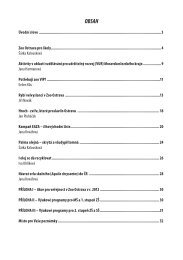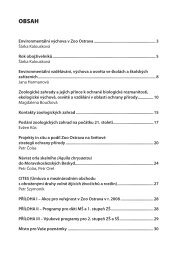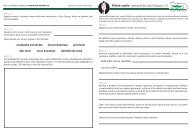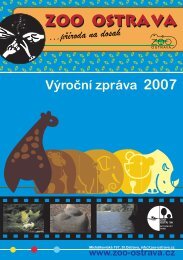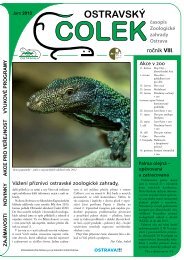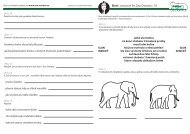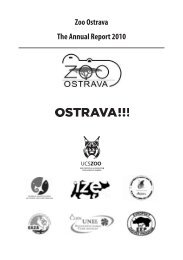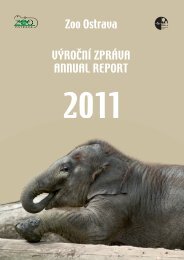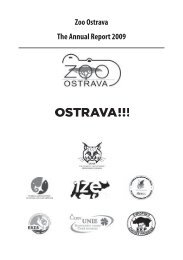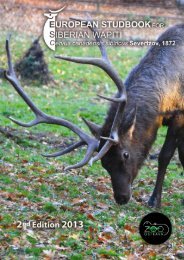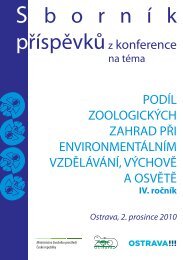The elephant updatesPavel ZvolánekThe previous year was filled with new developments not only for elephant friends and supporters, but alsofor the team of keepers.Jumbo the female transportedThe elephant team was not fortunate enough to include the female Jumbo into the female group in 2008.After Johti attacked Jumbo in summer 2008 (which could have yielded tragic consequences), it was decidedthat any further attempts to put the two females together should be given up and Jumbo placed in anotherzoo due to space issues. An interest was shown by Givskud <strong>Zoo</strong>, where they had kept elephant cows only ina display situation, which was an ideal option for Jumbo.As the female was never used to tying with chains, training started immediately upon the decision to transferJumbo. Within some three months of daily exercise, the female was able to withstand carrying the chains onall four legs even over longer periods almost without showing unhappy feelings. The transport took place on13 and 14 May <strong>2009</strong>, when the elephant was loaded in the morning; unfortunately, Jumbo fell twice on theground during the loading operation. The situation was handled namely thanks to the professionalism ofErnst Jan Kip of EKIPA - the transport company, as well as Jurgen Kruse and Christopher Wollner, elephantkeepers of Hannover <strong>Zoo</strong>, who had accompanied the male Calvin transported to <strong>Ostrava</strong> from Leipzig <strong>Zoo</strong>. Allthose persons have a long-term experience with transports like this and were essential for this one to succeed.Jumbo is now a member of Givskud herd of four Indian elephant cows with no troubles reported.Calvin arrived, managing the elephant bullThe Indian elephant bull Calvin was born at Calgary <strong>Zoo</strong>, Canada, in 1986. By the time of recommending Calvinby the breeding programme coordinator as a suitable male to join the <strong>Ostrava</strong> cows Johti and Vishesh, thiselephant had become father to 11 calves. In addition, Calvin is a bull from whom semen had been collectedon a routine basis, and the high rate of sperm motility, nearing 90%, was another factor contributing tothe decision. As the elephant house needed some arrangements before the bull could arrive, like erectinga restraint box and converting the gate connecting the outside enclosures from hand-operated to a powercontrolledmechanism, Calvin stayed in Leipzig from September 2008 to May <strong>2009</strong> to attempt to mate femalesfrom their prospective breeding group, and the date of transfer was eventually set to <strong>12</strong> May <strong>2009</strong>. Spendingten days prior the operation as an intern at Leipzig <strong>Zoo</strong>, I had the opportunity of becoming familiar with theway Calvin works and experiencing what this involved, as managing this male is different than with <strong>Ostrava</strong>females - Calvin is responsive to verbal commands without a need for a device called target.A single keeper working with an elephant bull is a common practice in other zoos; however, there are bydefault two trainers in <strong>Ostrava</strong> to avoid any failure to ensure Calvin's daily routine in the case of day-off,holiday or sick leave in a single person situation, although this is more complicated and the training progressis rather slow unlike with the standard one employing a single keeper. Nonetheless, this approach is believedto be the right one in terms of multi-year perspective.62
The way the bull was handled within three months upon male's arrival enabled the elephant team gettingCalvin into the restraint box and caring for the bull's skin by showering, as well as foot treatment. In addition,the elephant was able to exercise both outdoors and indoors (in the front male stall), even when visitors werepresent inside the house, although having been kept in special houses for elephant bulls behind the scenesbefore he arrived at <strong>Ostrava</strong> <strong>Zoo</strong>.Calvin introduced to the females, matingCalvin was uncrated at the zoo around mid-day on 13 May <strong>2009</strong>. Following loading the female Jumbo, whichtook two hours, the bull walked out of his crate smoothly within some ten minutes, this being somethingfor which thanks should go to no one but Calvin's long-term keeper Jurgen Kruse of Hannover, who hadaccompanied the transported male.Until 23 May, experience with Calvin and lessons learned could be shared with head keeper Michael Tempelhoffand his colleague Peter Kokisch from Leipzig <strong>Zoo</strong>. Thanks to their warning about several insufficiencies,namely in terms of gate security, which were handled very briefly, the elephant team could continue theirwork with Calvin very smoothly. Even though some lacks still existed and had to be resolved later, the currentmanagement of the elephant bull in <strong>Ostrava</strong> is safe for both the animal and the keepers.Calvin was first introduced to females Suseela and Vishesh in outdoor enclosures on 17 June. Johti was leftinside the house, as conflicts with the male were expected for reputed dominance of this female, so it wasdesired that Calvin first gets the opportunity to establish contacts with the females who were not assumed tomake difficulties, which was eventually confirmed. Everything went all right so as early as the next day, i.e. 18June, Calvin was reunited with the group. This time it involved all the females, which was still handled by thebull showing high experience and subsequently even mating Johti several times following ten minutes afterjoining the female group. In the afternoon, the bull could not be separated from the females, so the wholegroup was left outdoors without allowing the animals to enter the house.On the second day, Calvin continued mating Johti several times. This time the bull could be separated, somaking the indoor facilities available to the animals at night was now possible. From that day on, the malestayed out with the females each morning; in the afternoon the elephants were separated. All that time theanimals were undergoing their daily routine without any problems.On 30 June, Vishesh was mated by Calvin as well. After 16 weeks of waiting for test results, pregnancy wasconfirmed in both females based on testing urine samples collected on a routine basis, so there are goodchances that following the long gestation period, which in elephants takes almost two years, <strong>Ostrava</strong> <strong>Zoo</strong> cansee their elephant offspring - the first live-born calves in the history of elephant keeping in Czech zoos thatnow has exceeded 50 years.Sperm collectionAs not every zoo has the opportunity of keeping an elephant male, which applies to those in the country, butalso in Europe, the elephant sperm is used for artificial insemination, with <strong>Ostrava</strong> bull Calvin being one of thefew animals trained for such procedures. Included in the insemination scheme has also been one of Usti <strong>Zoo</strong>63
- Page 2 and 3:
Provozovatel zoo: Zoologická zahra
- Page 5 and 6:
ObsahÚvodní slovo ředitelePetr
- Page 7 and 8:
Vážení příznivci Zoo Ostrava,d
- Page 9 and 10:
Stavy chovaných zvířatChov zví
- Page 12 and 13:
pečovaly o mláďata z roku předc
- Page 15 and 16:
2) z účelově vázaného přísp
- Page 17 and 18:
Rok 2009 byl pro naši organizaci v
- Page 19 and 20:
Výnosy v roce 2009v tis.Kč% změn
- Page 21 and 22:
Osobní náklady tj. vlastní mzdy,
- Page 23 and 24:
Výstavba, projektová činnost a
- Page 25 and 26:
Z dalších změn v areálu zoo sto
- Page 27 and 28:
• byla dokončena projektová př
- Page 29 and 30:
Vzdělávací a propagační činno
- Page 31 and 32:
• 25.7. Když si zvířata hrají
- Page 33 and 34:
Činnost dendrologického oddělen
- Page 35 and 36:
Pozorování a sběr údajů o zví
- Page 37 and 38:
Rok šelem v Zoo OstravaMonika Ondr
- Page 39 and 40:
Historický nárůst počtu chovan
- Page 41 and 42:
Chov nového druhu primáta v Zoo O
- Page 43 and 44:
akovinným bujením, které zapří
- Page 45 and 46:
Odchov supa hnědého v Zoo Ostrava
- Page 47 and 48:
Repatriace supa hnědého a orlosup
- Page 49 and 50:
ještě před vylétnutím a jejich
- Page 51 and 52:
Odchov ohrožených druhů papoušk
- Page 53 and 54:
tuto budku přijali. Opět si vytvo
- Page 55 and 56:
pobývali většinou venku, mládě
- Page 57 and 58:
Novinky u slonůPavel ZvolánekRok
- Page 59 and 60:
při průchodu porodními cestami,
- Page 61 and 62:
Róze se poslední mládě narodilo
- Page 63 and 64:
Návrat orla skalního (Aquila chry
- Page 65 and 66:
Seznam zaměstnanců Zoo Ostrava (k
- Page 67 and 68:
Jméno Funkce Počet let v org.62 P
- Page 69 and 70:
Druh (poddruh)Species (subspecies)S
- Page 71 and 72:
Druh (poddruh)Species (subspecies)S
- Page 73 and 74:
Druh (poddruh)Species (subspecies)S
- Page 75 and 76:
Druh (poddruh)Species (subspecies)S
- Page 77 and 78:
Druh (poddruh)Species (subspecies)S
- Page 79 and 80:
Druh (poddruh)Species (subspecies)S
- Page 81 and 82:
Druh (poddruh)Species (subspecies)S
- Page 83 and 84:
Druh (poddruh)Species (subspecies)S
- Page 85 and 86:
Druh (poddruh)Species (subspecies)S
- Page 87 and 88:
Druh (poddruh)Species (subspecies)S
- Page 89 and 90:
Druh (poddruh)Species (subspecies)S
- Page 91 and 92:
Druh (poddruh)Species (subspecies)M
- Page 93 and 94:
FormaFormazajícovci (Lagomorpha)St
- Page 95 and 96:
▲ Nejvzácnější přírůstek r
- Page 97 and 98:
▲ Úprava vnitřních prostor v p
- Page 99 and 100:
▲ Odběr spermatu u samce slona i
- Page 101 and 102:
◀ Nový druh v Zoo Ostrava - peli
- Page 103 and 104:
▶ Pohlednice u voliéry supů hn
- Page 105 and 106:
◀ Google v zoo při sběru datpro
- Page 108 and 109:
Zoological Garden OstravaAddress: Z
- Page 111 and 112:
ContentsDirector´s introductory wo
- Page 113 and 114:
Dear friends,Ostrava Zoo is coming
- Page 115 and 116:
Animal numbersAnimal collection in
- Page 117 and 118:
of which a member of the very rare
- Page 119 and 120: success refers to the offspring pro
- Page 121 and 122: The founder’s non-capital funding
- Page 123 and 124: 3) CZK 737 thousand allocated to re
- Page 125 and 126: To co-fund 46.4% from the operating
- Page 127 and 128: As regards cost items in 2009, only
- Page 129 and 130: namely tiger enclosures, hoofed mam
- Page 131 and 132: Design, development and maintenance
- Page 133 and 134: This operation was supported by the
- Page 135 and 136: • Development of the building app
- Page 137 and 138: Ostrava Zoo - the zoo office and ma
- Page 139 and 140: Again, the event was co-funded by t
- Page 141 and 142: and involved models of a turtle she
- Page 143 and 144: Activities of the Horticulture Depa
- Page 145 and 146: and it was carried out by the scien
- Page 147 and 148: A year of carnivores at Ostrava Zoo
- Page 149 and 150: Historical increase in the number o
- Page 151 and 152: Keeping a new primate species at Os
- Page 153 and 154: for the lemurs, where the family of
- Page 155 and 156: Month 8 Beira's climbing the ropes
- Page 157 and 158: as the birds changed over on 28 Apr
- Page 159 and 160: • Birds of prey are rather slow i
- Page 161 and 162: Monitoring nests of endangered bird
- Page 163 and 164: The yellow cardinal at Ostrava ZooY
- Page 165 and 166: a bowl with fresh water multiple ti
- Page 167 and 168: it was found that one egg was impre
- Page 169: eginnings when the young are fed by
- Page 173 and 174: Keeping the common hippopotamus (Hi
- Page 175 and 176: Studbook # /nameSexDate ofbirthDam/
- Page 177 and 178: General summaryThanks to the projec
- Page 179 and 180: NamePositionNumber of yearsin the o



